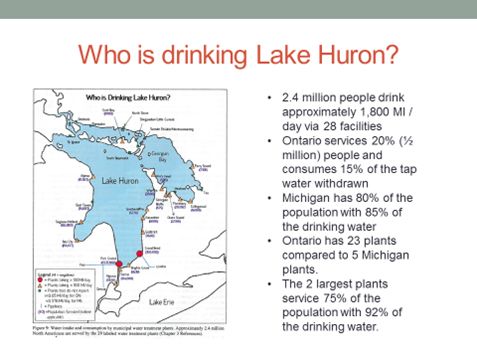Water, water everywhere but ...

“Water, water, every where, Nor any drop to drink.”
– Samuel Taylor Coleridge, The Rime of the Ancient Mariner
‘Water, water everywhere but …’
People are funny. They often take for granted the most precious things that lie right under their noses. Take water for example. In Southwestern Ontario we live on a peninsula surrounded by the Great Lakes; the largest assemblage of fresh water in the world. Yet for many, we neither understand them nor realize how critical they are to our day-to-day lives. Take two examples for instance.
Case #1 – Where did the water go?
With these huge reservoirs of fresh water situated so very close to homes and vacation spots, we often find that people assume the water levels are manually controlled somehow. This is especially true of newcomers who have not grown up or ‘cottaged’ on the Lake Huron shores. Federal and provincial governments do not help reduce the confusion when they speak of regulations that ‘control’ Lake Ontario or Lake Superior when in reality, the ‘controls’ are mere centimetres of influence compared to metres of natural water level fluctuation (in vertical distances).
Take Lake Erie, for example. A persistent west wind can blow down the length of the lake from Toledo to Buffalo (or Point Pelee to Fort Erie) and ‘set up’ or ‘push’ lake water from one end to the other making water level changes in the order of metres of vertical change. Granted Lake Erie is the shallowest of our Great Lakes but this same phenomenon, referred to as a ‘seiche,’ can also occur in bays such as in Saginaw or Georgian Bay. If they are keeping a close watch, shoreline landowners may notice daily fluctuations as the water ‘sloshes’ back and forth like a water basin being rocked like a cradle.

In Lake Huron, along the southeast shore, seiches are not common but a different type of water level change can occur during intense storm activity. Take, for example, the F3 tornado in Goderich in 2011. The water level gauge that is situated in the harbour records hourly water level fluctuations. The intense low-pressure system that draws air into the centre of the funnel and makes it rise up in a cataclysmic weather phenomenon also creates such a low-pressure system, it will redistributes water as well. Although the tornado path was so rapid that it is difficult to obtain recordings such as at the water level gauge in Goderich Harbour, many first-hand witness accounts suggest the water was drawn out of the harbour and then rushed back in moments later as the tornado passed over.
This type of occurrence and the damage that resulted to moored boats and ships, is well documented by insurance companies in their claims for damages to ships in the deep water port when storms over the years have caused harbour damage. These insurance companies had to complete their due diligence and double-check the facts of claim only to find out the claims were accurate and as a result of rapid water level changes, all due to ‘Mother Nature.’
Case #2 – Who is drinking Lake Huron?
Although no one recommends drinking water directly from Lake Huron (seagull feces is one of the pollutants that can create issues), many shoreline municipalities receive their treated drinking water from the lake. The Lake Huron Primary Water Supply System facility, near Grand Bend, takes more than 100 Mega Litres of water per day, treats it and sends it to 14 nearby communities including the coastal communities of Bayfield, Port Franks and all areas in between. Additional municipalities who benefit from this pipeline water also include London, Komoka, Strathroy, Hensall, Exeter, and Lucan, among others. Compare this with the total amount of water treated for drinking water for populations on both sides of Lake Huron.
Ontario communities have many more water treatment facilities than their counterparts in Michigan with 23 on the Ontario side and five on the Michigan side. These two jurisdictions withdraw 1,800 Mega Litres per day to quench the thirst of 2.4 million people. Michigan has 80 per cent of the population but consumes 85 per cent of the treated water while Ontario side of the lake has 20 per cent of the population but consumes 15 per cent of the treated water. Our Michigan neighbours appear to be thirstier than our fellow Ontario citizens.

Everything considered, we live next to some very large, very beautiful, and very important water resources that we should never take for granted. The more we learn about ‘our’ Lake Huron, the more we will understand it. The more we understand it, the more we will take care of it.
